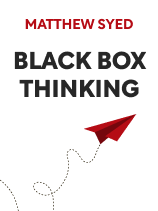

This article is an excerpt from the Shortform book guide to "Black Box Thinking" by Matthew Syed. Shortform has the world's best summaries and analyses of books you should be reading.
Like this article? Sign up for a free trial here .
What is an MVP test? How does an organization use the MVP test to improve?
An MVP test is a way to test out a product by building out a prototype or stripped-down version of the product and then gathering feedback to act upon. The author of Black Box Thinking uses the minimum viable product test as an example of how learning-oriented institutions grow from failure.
Keep reading to find out how lean startups use MVP tests to gather feedback.
MVP Tests Embrace Failure
With a failure-embracing mindset in place, you need a system that makes use of failure. Syed argues that this system is the bottom-up method. In other words, scientists, lean startups, and athletic organizations all iterate to develop theories, products, and skills.
Succeeding with this strategy isn’t easy—you have to fail, fail, and fail some more. It takes tenacity, humility, and ambition to slowly adapt your creation according to what actually works.
(Shortform note: Ryan Holiday argues in The Obstacle Is The Way that to make it in our complex, uncertain world, we need to cultivate a deep resilience to hardship. You can do so by resolving to achieve some goal no matter what, and sticking to that commitment at all costs. Repeatedly sticking to your commitments builds long-term resilience into your character. Similarly, Nassim Nicholas Taleb argues in Antifragile that we ought to become not resilient, but antifragile—rather than merely enduring stress, use it to grow ever stronger. Both individuals and organizations can take hardships as lessons to learn—similarly to how muscles grow through the minor injuries of exercise.)
Iterate Minimum Viable Products
Syed gives one key example of the iterative process in business: the minimum viable product (MVP test). To navigate the unpredictable marketplace, lean startups test out their ideas using stripped-down versions of the potential end products.
- Test out your ideas by building an MVP test, and see what happens. Imagine that a startup founder wants to create a new social platform that emphasizes empathetic conversation and tight-knit social groups. To test this idea, she could mock up a video that demonstrates how these features would work.
- Launching an MVP test gets you feedback—whether people are interested and, if so, what they do and don’t like about your product. After launching her video, the founder might find that only some social groups are interested, but they have concerns about whether or not social media is right for a deeper connection.
- Adjust to that feedback—the founder’s idea found little support, but she’s only sunk a little time and money into the MVP test—as opposed to a great deal of time and money into a full-blown product. Now she can decide whether to explore other options. She’s learned what won’t work and can take her ideas in a new direction.
| Test Internally to Validate Ideas While jumping right to action can work, it’s often better to test ideas internally before seeking customer feedback via an MVP test. In Inspired, Marty Cagan explains that a software product idea should pass four tests before your company invests in it: 1. Value: A product must provide significant value that customers can’t find elsewhere. Test for a market niche by launching a web page that appears to offer the product idea but leads to an interest form. If many customers click through, that’s a good sign. 2. Usability: If your product is easy to pick up and use, it’s more likely to succeed. Recruit potential users via email, set them up with a prototype of your product, and take note on how they instinctively use it. 3. Feasibility: If your team can realistically build the product, it’s feasible. To test this, simply have your engineers build enough of the project that they’re confident they could finish it (or, build a complete prototype). 4. Viability: When your team agrees that the product will be profitable, it’s viable. Focus on finance and leadership—if you can’t afford it, or it doesn’t fit your business strategy, the product might flop. While you can’t ensure 100% certainty about these factors, you can separate a good deal of chaff from the wheat. This way, you avoid investing in ideas that you haven’t validated and improve your chances of success. Further, be sure to tap the whole team’s expertise—a software engineer can speak to product feasibility, but the CEO will better understand whether an idea fits the company’s mission and strategy. |

———End of Preview———
Like what you just read? Read the rest of the world's best book summary and analysis of Matthew Syed's "Black Box Thinking" at Shortform .
Here's what you'll find in our full Black Box Thinking summary :
- How an organization’s culture and systems either promote or prevent learning
- The steps for learning from failure in our complex world
- How to shift mindsets around failure to promote a learning-oriented institution






